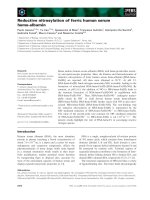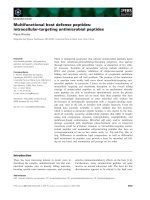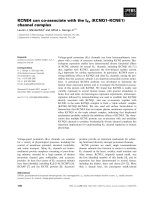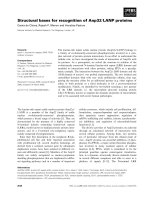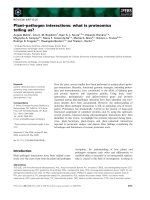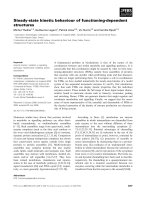Tài liệu Báo cáo khoa học: "Unsupervised Semantic Role Induction with Global Role Ordering" doc
Bạn đang xem bản rút gọn của tài liệu. Xem và tải ngay bản đầy đủ của tài liệu tại đây (177.77 KB, 5 trang )
Proceedings of the 50th Annual Meeting of the Association for Computational Linguistics, pages 145–149,
Jeju, Republic of Korea, 8-14 July 2012.
c
2012 Association for Computational Linguistics
Unsupervised Semantic Role Induction with Global Role Ordering
Nikhil Garg
University of Geneva
Switzerland
James Henderson
University of Geneva
Switzerland
Abstract
We propose a probabilistic generative model
for unsupervised semantic role induction,
which integrates local role assignment deci-
sions and a global role ordering decision in a
unified model. The role sequence is divided
into intervals based on the notion of primary
roles, and each interval generates a sequence
of secondary roles and syntactic constituents
using local features. The global role ordering
consists of the sequence of primary roles only,
thus making it a partial ordering.
1 Introduction
Unsupervised semantic role induction has gained
significant interest recently (Lang and Lapata,
2011b) due to limited amounts of annotated corpora.
A Semantic Role Labeling (SRL) system should
provide consistent argument labels across different
syntactic realizations of the same verb (Palmer et al.,
2005), as in
(a.) [ Mark ]
A0
drove [ the car ]
A1
(b.) [ The car ]
A1
was driven by [ Mark ]
A0
This simple example also shows that while certain
local syntactic and semantic features could provide
clues to the semantic role label of a constituent, non-
local features such as predicate voice could provide
information about the expected semantic role se-
quence. Sentence a is in active voice with sequence
(A0, P REDICA T E, A1) and sentence b is in passive
voice with sequence (A1, P R EDICAT E, A0). Addi-
tional global preferences, such as arguments A0 and
A1 rarely repeat in a frame (as seen in the corpus),
could also be useful in addition to local features.
Supervised SRL systems have mostly used local
classifiers that assign a role to each constituent inde-
pendently of others, and only modeled limited cor-
relations among roles in a sequence (Toutanova et
al., 2008). The correlations have been modeled via
role sets (Gildea and Jurafsky, 2002), role repeti-
tion constraints (Punyakanok et al., 2004), language
model over roles (Thompson et al., 2003; Pradhan
et al., 2005), and global role sequence (Toutanova
et al., 2008). Unsupervised SRL systems have ex-
plored even fewer correlations. Lang and Lapata
(2011a; 2011b) use the relative position (left/right)
of the argument w.r.t. the predicate. Grenager and
Manning (2006) use an ordering of the linking of se-
mantic roles and syntactic relations. However, as the
space of possible linkings is large, language-specific
knowledge is used to constrain this space.
Similar to Toutanova et al. (2008), we propose to
use global role ordering preferences but in a gener-
ative model in contrast to their discriminative one.
Further, unlike Grenager and Manning (2006), we
do not explicitly generate the linking of semantic
roles and syntactic relations, thus keeping the pa-
rameter space tractable. The main contribution of
this work is an unsupervised model that uses global
role ordering and repetition preferences without as-
suming any language-specific constraints.
Following Gildea and Jurafsky (2002), previous
work has typically broken the SRL task into (i) argu-
ment identification, and (ii) argument classification
(M`arquez et al., 2008). The latter is our focus in this
work. Given the dependency parse tree of a sentence
with correctly identified arguments, the aim is to as-
sign a semantic role label to each argument.
145
Algorithm 1 Generative process
—————– PARAMETERS —————–
for all predicate p do
for all voice vc ∈ {active, passive} do
draw θ
order
p,vc
∼ Dirichlet(α
order
)
for all interval I do
draw θ
SR
p,I
∼ Dirichlet(α
SR
)
for all adjacency adj ∈ {0, 1} do
draw θ
ST OP
p,I,adj
∼ Beta(α
ST OP
)
for all role r ∈ P R ∪ SR do
for all feature type f do
draw θ
F
p,r,f
∼ Dirichlet(α
F
)
———————– DATA ———————–
given a predicate p with voice vc:
choose an ordering o ∼ Multinomial(θ
order
p,vc
)
for all interval I ∈ o do
draw an indicator s ∼ Binomial (θ
ST OP
p,I,0
)
while s = ST OP do
choose a SR r ∼ Multinomial(θ
SR
p,I
)
draw an indicator s ∼ Binomial (θ
ST OP
p,I,1
)
for all generated roles r do
for all feature type f do
choose a value v
f
∼ Mult inomial(θ
F
p,r,f
)
2 Proposed Model
We assume the roles to be predicate-specific. We
begin by introducing a few terms:
Primary Role (PR) For every predicate, we assume
the existence of K primary roles (PRs) denoted by
P
1
, P
2
, , P
K
. These roles are not allowed to re-
peat in a frame and serve as “anchor points” in the
global role ordering. Intuitively, the model attempts
to choose PRs such that they occur with high fre-
quency, do not repeat, and their ordering influences
the positioning of other roles. Note that a PR may
correspond to either a core role or a modifier role.
For ease of explication, we create 3 additional PRs:
ST ART denoting the start of the role sequence, END
denoting its end, and P RED denoting the predicate.
Secondary Role (SR) The roles that are not PRs are
called secondary roles (SRs). Given N roles in total,
there are (N − K) SRs, denoted by S
1
, S
2
, , S
N−K
.
Unlike PRs, SRs are not constrained to occur only
once in a frame and do not participate in the global
role ordering.
Interval An interval is a sequence of SRs bounded
by PRs, for instance (P
2
, S
3
, S
5
, P RED).
Ordering An ordering is the sequence of PRs ob-
served in a frame. For example, if the complete role
Figure 1: Proposed model. Shaded and unshaded
nodes represent visible and hidden variables resp.
sequence is (ST ART , P
2
, S
1
, S
1
, PRED, S
3
, END), the
ordering is defined as (ST ART , P
2
, P RED, END).
Features We have explored 1 frame level (global)
feature (i) voice: active/passive, and 3 argument
level (local) features (i) deprel: dependency relation
of an argument to its head in the dependency parse
tree, (ii) head: head word of the argument, and (iii)
pos-head: Part-of-Speech tag of head.
Algorithm 1 describes the generative story of our
model and Figure 1 illustrates it graphically. Given a
predicate and its voice, an ordering is selected from
a multinomial. This ordering gives us the sequence
of PRs (P R
1
, PR
2
, , P R
N
). Each pair of consec-
utive PRs, P R
i
, P R
i+1
, in an ordering corresponds
to an interval I
i
. For each such interval, we generate
0 or more SRs (SR
i1
, SR
i2
, SR
iM
) as follows.
Generate an indicator variable: CONTINUE/ST OP
from a binomial distribution. If CONTINUE, gen-
erate a SR from the multinomial corresponding to
the interval. Generate another indicator variable and
continue the process till a ST O P has been generated.
In addition to the interval, the indicator variable also
depends on whether we are generating the first SR
(adj = 0) or a subsequent one (adj = 1). For each
role, primary as well as secondary, we now generate
the corresponding constituent by generating each of
its features independently (F
1
, F
2
, , F
T
).
Given a frame instance with predicate p and voice
vc, Figure 2 gives (i) Eq. 1: the joint distribution
of the ordering o, role sequence r, and constituent
sequence f , and (ii) Eq. 2: the marginal distribution
of an instance. The likelihood of the whole corpus
is the product of marginals of individual instances.
146
P (o, r, f |p, vc) = P (o|p, vc)
ordering
∗ Π
{r
i
∈r∩P R}
P (f
i
|r
i
, p)
Primary Roles
∗ Π
{I∈o}
P (r(I), f (I)|I, p)
Intervals
(1)
where P (r(I), f (I)|I, p) =
r
i
∈r(I)
P (continue|I, p, adj)
generate indicator
P (r
i
|I, p)
generate SR
P (f
i
|r
i
, p)
generate features
∗ P (stop|I, p, adj)
end of the interval
and P (f
i
|r
i
, p) = Π
t
P (f
i,t
|r
i
, p)
P (f |p, vc) = Σ
o
Σ
{r∈seq(o)}
P (o, r, f |p, vc) where seq(o) = {role sequences allowed under ordering o} (2)
Figure 2: r
i
and f
i
denote the role and features at position i respectively, and r(I) and f (I) respectively
denote the SR sequence and feature sequence in interval I. f
i,t
denotes the value of feature t at position i.
This particular choice of model is inspired from
different sources. Firstly, making the role order-
ing dependent only on PRs aligns with the obser-
vation by Pradhan et al. (2005) and Toutanova et
al. (2008) that including the ordering information
of only core roles helped improve the SRL perfor-
mance as opposed to the complete role sequence.
Although our assumption here is softer in that we
assume the existence of some roles which define
the ordering which may or may not correspond to
core roles. Secondly, generating the SRs indepen-
dently of each other given the interval is based on
the intuition that knowing the core roles informs
us about the expected non-core roles that occur be-
tween them. This intuition is supported by the statis-
tics in the annotated data, where we found that if we
consider the core roles as PRs, then most of the in-
tervals tend to have only a few types of SRs and a
given SR tends to occur only in a few types of in-
tervals. The concept of intervals is also related to
the linguistic theory of topological fields (Diderich-
sen, 1966; Drach, 1937). This simplifying assump-
tion that given the PRs at the interval boundary, the
SRs in that interval are independent of the other
roles in the sequence, keeps the parameter space lim-
ited, which helps unsupervised learning. Thirdly,
not allowing some or all roles to repeat has been
employed as a useful constraint in previous work
(Punyakanok et al., 2004; Lang and Lapata, 2011b),
which we use here for PRs. Lastly, conditioning the
(ST OP/CONTINUE) indicator variable on the adja-
cency value (adj) is inspired from the DMV model
(Klein and Manning, 2004) for unsupervised depen-
dency parsing. We found in the annotated corpus
that if we map core roles to PRs, then most of the
time the intervals do not generate any SRs at all. So,
the probability to ST OP should be very high when
generating the first SR.
We use an EM procedure to train the model. In
the E-step, we calculate the expected counts of all
the hidden variables in our model using the Inside-
Outside algorithm (Baker, 1979). In the M-step, we
add the counts corresponding to the Bayesian priors
to the expected counts and use the resulting counts
to calculate the MAP estimate of the parameters.
3 Experiments
Following the experimental settings of Lang and La-
pata (2011b), we use the CoNLL 2008 shared task
dataset (Surdeanu et al., 2008), only consider ver-
bal predicates, and run unsupervised training on the
standard training set. The evaluation measures are
also the same: (i) Purity (PU) that measures how
well an induced cluster corresponds to a single gold
role, (ii) Collocation (CO) that measures how well
a gold role corresponds to a single induced cluster,
and (iii) F1 which is the harmonic mean of PU and
CO. Final scores are computed by weighting each
predicate by the number of its argument instances.
We chose a uniform Dirichlet prior with concentra-
tion parameter as 0.1 for all the model parameters
in Algorithm 1 (set roughly, without optimization
1
).
50 training iterations were used.
3.1 Results
Since the dataset has 21 semantic roles in total, we
fix the total number of roles in our model to be 21.
Further, we set the number of PRs to 2 (excluding
ST ART , END and P RED), and SRs to 21-2=19.
1
Removing the Bayesian priors completely, resulted in the
EM algorithm getting to a local maxima quite early, giving a
substantially lower performance.
147
Model Features PU CO F1
0 Baseline
2
d 81.6 78.1 79.8
1a Proposed d 82.3 78.6 80.4
1b Proposed d,h 82.7 77.2 79.9
1c Proposed d,p-h 83.5 78.5 80.9
1d Proposed d,p-h,h 83.2 77.1 80.0
Table 1: Evaluation. d refers to deprel, h refers to
head and p-h refers to pos-head.
Table 1 gives the results using different feature
combinations. Line 0 reports the performance of
Lang and Lapata (2011b)’s baseline, which has been
shown difficult to outperform. This baseline maps
20 most frequent deprel to a role each, and the rest
are mapped to the 21st role. By just using deprel as
a feature, the proposed model outperforms the base-
line by 0.6 points in terms of F1 score. In this con-
figuration, the only addition over the baseline is the
ordering model. Adding head as a feature leads to
sparsity, which results in a substantial decrease in
collocation (lines 1b and 1d). However, just adding
pos-head (line 1c) does not cause this problem and
gives the best F1 score. To address sparsity, we in-
duced a distributed hidden representation for each
word via a neural network, capturing the semantic
similarity between words. Preliminary experiments
improved the F1 score when using this word repre-
sentation as a feature instead of the word directly.
Lang and Lapata (2011b) give the results of three
methods on this task. In terms of F1 score, the La-
tent Logistic and Graph Partitioning methods result
in slight reduction in performance over the baseline,
while the Split-Merge method results in an improve-
ment of 0.6 points. Table 1, line 1c achieves an im-
provement of 1.1 points over the baseline.
3.2 Further Evaluation
Table 2 shows the variation in performance w.r.t.
the number of PRs
3
in the best performing config-
uration (Table 1, line 1c). On one extreme, when
there are 0 PRs, there are only two possible in-
tervals: (ST ART,P RED) and (P RED, END) which
means that the only context information a SR has
is whether it is to the left or right of the predicate.
2
The baseline F1 reported by Lang and Lapata (2011b) is
79.5 due to a bug in their system (personal communication).
3
Note that the system might not use all available PRs to label
a given frame instance. #PRs refers to the max #PRs.
# PRs PU CO F1
0 81.67 78.07 79.83
1 82.91 78.99 80.90
2 83.54 78.47 80.93
3 83.68 78.23 80.87
4 83.72 78.08 80.80
Table 2: Performance variation with the number of
PRs (excluding ST ART , END and P RED)
With only this additional ordering information, the
performance is the same as the baseline. Adding just
1 PR leads to a big increase in both purity and col-
location. Increasing the number of PRs beyond 1
leads to a gradual increase in purity and decline in
collocation, with the best F1 score at 2 PRs. This
behavior could be explained by the fact that increas-
ing the number of PRs also increases the number of
intervals, which makes the probability distributions
more sparse. In the extreme case, where all the roles
are PRs and there are no SRs, the model would just
learn the complete sequence of roles, which would
make the parameter space too large to be tractable.
For calculating purity, each induced cluster (or
role) is mapped to a particular gold role that has
the maximum instances in the cluster. Analyzing the
output of our model (line 1c in Table 1), we found
that about 98% of the PRs and 40% of the SRs got
mapped to the gold core roles (A0,A1, etc.). This
suggests that the model is indeed following the intu-
ition that (i) the ordering of core roles is important
information for SRL systems, and (ii) the intervals
bounded by core roles provide good context infor-
mation for classification of other roles.
4 Conclusions
We propose a unified generative model for unsu-
pervised semantic role induction that incorporates
global role correlations as well as local feature infor-
mation. The results indicate that a small number of
ordered primary roles (PRs) is a good representation
of global ordering constraints for SRL. This repre-
sentation keeps the parameter space small enough
for unsupervised learning.
Acknowledgments
This work was funded by the Swiss NSF grant
200021
125137 and EC FP7 grant PARLANCE.
148
References
J.K. Baker. 1979. Trainable grammars for speech recog-
nition. The Journal of the Acoustical Society of Amer-
ica, 65:S132.
P. Diderichsen. 1966. Elementary Danish Grammar.
Gyldendal, Copenhagen.
E. Drach. 1937. Grundstellung der Deutschen Satzlehre.
Diesterweg, Frankfurt.
D. Gildea and D. Jurafsky. 2002. Automatic label-
ing of semantic roles. Computational Linguistics,
28(3):245–288.
T. Grenager and C.D. Manning. 2006. Unsupervised dis-
covery of a statistical verb lexicon. In Proceedings of
the 2006 Conference on Empirical Methods in Natu-
ral Language Processing, pages 1–8. Association for
Computational Linguistics.
D. Klein and C.D. Manning. 2004. Corpus-based in-
duction of syntactic structure: Models of dependency
and constituency. In Proceedings of the 42nd Annual
Meeting on Association for Computational Linguis-
tics, page 478. Association for Computational Linguis-
tics.
J. Lang and M. Lapata. 2011a. Unsupervised semantic
role induction via split-merge clustering. In Proceed-
ings of the 49th Annual Meeting of the Association for
Computational Linguistics, Portland, Oregon.
J. Lang and M. Lapata. 2011b. Unsupervised seman-
tic role induction with graph partitioning. In Proceed-
ings of the 2011 Conference on Empirical Methods in
Natural Language Processing, pages 1320–1331, Ed-
inburgh, Scotland, UK., July. Association for Compu-
tational Linguistics.
L. M`arquez, X. Carreras, K.C. Litkowski, and S. Steven-
son. 2008. Semantic role labeling: an introduc-
tion to the special issue. Computational linguistics,
34(2):145–159.
M. Palmer, D. Gildea, and P. Kingsbury. 2005. The
proposition bank: An annotated corpus of semantic
roles. Computational Linguistics, 31(1):71–106.
S. Pradhan, K. Hacioglu, V. Krugler, W. Ward, J.H. Mar-
tin, and D. Jurafsky. 2005. Support vector learning for
semantic argument classification. Machine Learning,
60(1):11–39.
V. Punyakanok, D. Roth, W. Yih, and D. Zimak. 2004.
Semantic role labeling via integer linear programming
inference. In Proceedings of the 20th international
conference on Computational Linguistics, page 1346.
Association for Computational Linguistics.
M. Surdeanu, R. Johansson, A. Meyers, L. M`arquez, and
J. Nivre. 2008. The conll-2008 shared task on joint
parsing of syntactic and semantic dependencies. In
Proceedings of the Twelfth Conference on Computa-
tional Natural Language Learning, pages 159–177.
Association for Computational Linguistics.
C. Thompson, R. Levy, and C. Manning. 2003. A gen-
erative model for semantic role labeling. Machine
Learning: ECML 2003, pages 397–408.
K. Toutanova, A. Haghighi, and C.D. Manning. 2008. A
global joint model for semantic role labeling. Compu-
tational Linguistics, 34(2):161–191.
149



